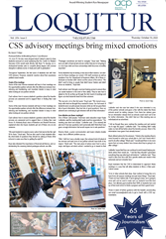 Meghan Hurley
Meghan HurleyCabrini College students have received excellent scores in two national studies.
One study placed Cabrini students in the top half of the nation in five areas of student engagement in their own education.
A second study placed Cabrini students in the top 20 percent in the nation in the amount they grew from freshman through graduation in the areas of communication and critical thinking.
Faculty and staff who have studied the survey results say both surveys show the strengths of a Cabrini education as well as point to areas that will be addressed by the $1.9 million grant received from the federal government in October.
One survey shows that students who are personally engaged in educational activities are benefiting from their involvement. As students jump into educational activities as active learners, they are improving in student learning and development as measured by national tests. Active student involvement includes collaborative learning, student-faculty interaction and enriching educational experiences.
This past year, freshman and seniors participated in the National Survey of Student Engagement. The survey measures “engagement,” or how involved students are in academics and campus activities. Chad May, the director of institutional research, said, “It’s used to compare our first year and senior experiences and to get an overall measure.”
Results from the NSSE show that first-year and senior students are in the top half of students from 528 four-year colleges and universities in all five benchmarks of effective educational practice: level of academic challenge, active and collaborative learning, student-faculty interaction, enriching educational experiences, and supportive campus environment.
Now in its seventh year, the survey, known as “Nessie” after its acronym NSSE, covered 260,000 freshman and seniors according to the Chronicle of Higher Education.
Dr. Charlie McCormick, dean for academic affairs, said, “If we just do it to get the numbers, the exercise is meaningless.”
McCormick and May agreed that the survey was a valuable instrument. May explained that the survey is used for three main reasons. The survey is used to look at the curriculum as well to leverage the decision-making. Also, the survey is used as a measure for the Title III grant, a $1.87 million grant received from the federal government. The purpose of the U.S. Department of Education’s Title III Strengthening Institutions grant that the college recently was awarded is to supply eligible institutions with abilities to improve academics, strengthen contribution to nationwide higher education programs, increase institutional management and sustain fiscal stability.
May also said that the surveys helped the college focus on the first-year experience.
The survey was conducted in February of 2005 and was completed in April. Cabrini takes part in the survey every three years. NSSE surveyed 331,601 students nationwide, including 283 freshmen and 146 seniors from Cabrini.
McCormick said, “Nessie is an institutional snapshot.”
Cabrini also participated in the Collegiate Learning Assessment. According to the CLA, students graduated with more than predicted growth in key communication and critical thinking skills. Nationally, 8,900 students from 123 colleges and universities participated in the CLA. The CLA is a central focus of the Council for Aid to Education, a national non-profit organization based in New York City committed to improving quality and access in higher education.


